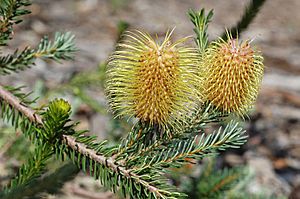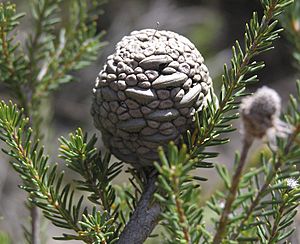Teasel banksia facts for kids
Quick facts for kids Teasel banksia |
|
|---|---|
 |
|
| Banksia pulchella, in Kings Park | |
| Scientific classification | |
| Kingdom: | |
| (unranked): | |
| (unranked): | |
| Order: | |
| Family: | |
| Genus: | |
| Species: |
B. pulchella
|
| Binomial name | |
| Banksia pulchella |
|
| Synonyms | |
|
Sirmuellera pulchella (R.Br.) Kuntze |
|
The Teasel Banksia, also known as Banksia pulchella, is a type of small shrub. It grows only in the south-west part of Western Australia. This plant has smooth grey bark, long, thin leaves, and pretty golden-brown flowers. These flowers grow in short, round clusters. After flowering, it produces small, hard fruits called follicles, which are not very easy to see.
Contents
What Does Teasel Banksia Look Like?
The Teasel Banksia is a shrub that usually grows to about 1 meter (3 feet) tall. It has smooth, grey bark. Unlike some other plants, it does not have a special woody lump at its base called a lignotuber, which helps plants regrow after fire.
Its leaves are very narrow and thin, like lines. They are about 5 to 15 millimeters (0.2 to 0.6 inches) long and less than 1 millimeter wide. Each leaf has a short stem, about 1 to 1.5 millimeters long, and a sharp point at its tip.
The flowers are a beautiful golden-brown color with bright yellow parts called styles. They grow in short, cylinder-shaped heads. These flower heads are about 20 to 25 millimeters (0.8 to 1 inch) long and 35 to 50 millimeters (1.4 to 2 inches) wide when they are blooming. Small leaf-like structures called bracts are found at the base of the flower head, but they fall off as the flowers grow.
Each individual flower has a part called a perianth, which is about 17 to 19 millimeters long. The pistil, which is the female part of the flower, is about 27 to 30 millimeters long and has a hooked shape. Teasel Banksia usually blooms in January, March, or from May to October.
After the flowers, the plant produces small, hard fruits called follicles. These follicles are about 8 to 17 millimeters long, up to 3 millimeters high, and 7 millimeters wide. They are not very noticeable, especially because the old flowers fall away from the head.
How Did Teasel Banksia Get Its Name?
The Teasel Banksia was first officially described by a botanist named Robert Brown. He wrote about it in a publication called Transactions of the Linnean Society of London. Robert Brown collected samples of this plant from different places along the south coast of Western Australia.
Later, in 1981, another expert named Alex George chose the samples that Brown collected at Lucky Bay as the main example for this species. This main example is called a lectotype.
The second part of the plant's scientific name, pulchella, comes from a Latin word meaning "pretty." This name likely refers to the beautiful flowers of the Teasel Banksia.
Where Does Teasel Banksia Grow?
The Teasel Banksia grows in areas with tall shrubs and a type of plant community called kwongan. Kwongan is a unique kind of shrubland found in Western Australia. This plant is found along the south coast of Western Australia. You can find it from Culham Inlet in the Fitzgerald River National Park all the way east to Israelite Bay.
Is Teasel Banksia Safe?
The government of Western Australia, through its Department of Parks and Wildlife, has checked on the Teasel Banksia. They have officially stated that this banksia species is "not threatened." This means it is not currently in danger of disappearing.
Growing Teasel Banksia
If you want to grow Teasel Banksia from seeds, you don't need to do anything special to the seeds before planting them. The seeds usually start to sprout, or germinate, within 17 to 48 days after being planted.


